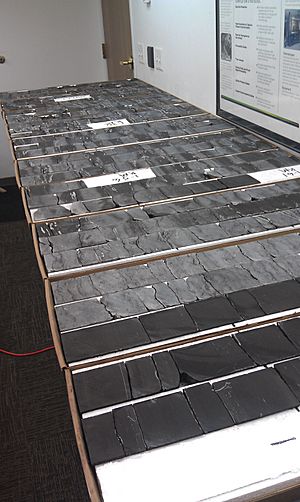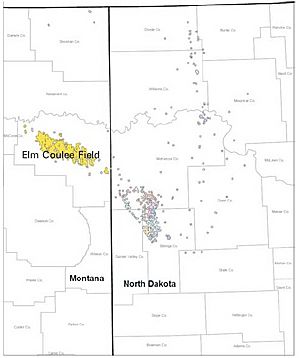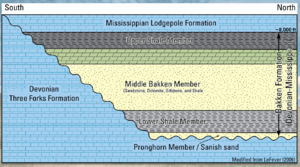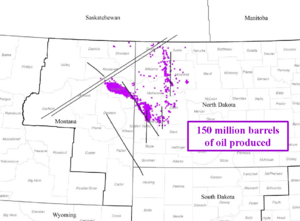Bakken Formation facts for kids
Quick facts for kids Bakken FormationStratigraphic range: Late Devonian-Early Mississippian ~380–340Ma |
|
|---|---|

Cut Bakken core samples
|
|
| Type | Geological formation |
| Unit of | Three Forks Group |
| Underlies | Madison Limestone |
| Overlies | Wabamun, Big Valley & Torquay Formations |
| Area | 200,000 square miles (520,000 km2) |
| Thickness | up to 40 metres (130 ft) |
| Lithology | |
| Primary | Shale, dolomite |
| Other | Sandstone, siltstone |
| Location | |
| Coordinates | 48°23′34″N 102°56′24″W / 48.3929°N 102.9399°W |
| Region | Central North America |
| Country | |
| Extent | Williston Basin |
| Type section | |
| Named for | Henry Bakken |
| Named by | J.W. Nordquist |
| Year defined | 1953 |
 Map of the Bakken Formation reservoirs in the US portion of the Williston Basin (Saskatchewan is north border). Prior to 2007, most oil came from the Elm Coulee Oil Field |
|
The Bakken Formation is a special layer of rock found deep underground. It formed a very long time ago, during the Late Devonian and Early Mississippian periods. This rock layer covers a huge area, about 200,000 square miles (520,000 km2), beneath parts of Montana, North Dakota, Saskatchewan, and Manitoba.
A geologist named J.W. Nordquist first described the Bakken Formation in 1953. It's named after Henry Bakken, a farmer from Tioga, North Dakota. The formation was found on his land when people were drilling for oil. You can't see the Bakken Formation on the surface because it's completely buried deep underground.
The Bakken Formation is very important because it contains a lot of oil. Oil was first found here in 1951. For a long time, it was hard to get the oil out. But new technologies have made it much easier.
Contents
What Makes the Bakken Formation Special?
The Bakken Formation is a major source of oil in North America. In April 2008, experts estimated that about 3 to 4.3 billion barrels of oil could be recovered from it using available technology. Newer estimates suggest even more oil can be recovered.
How Do We Get Oil from the Bakken?
Since the year 2000, two main technologies have helped a lot with getting oil from the Bakken:
- Hydraulic fracturing (often called "fracking"): This involves pumping water, sand, and chemicals into the rock at high pressure to create tiny cracks. These cracks allow the oil to flow out.
- Horizontal drilling: Instead of drilling straight down, this method allows drillers to turn the well sideways and drill horizontally through the oil-rich rock layer. This way, they can reach much more oil from a single well.
These methods have caused a big increase in oil production. By the end of 2010, so much oil was being produced that there weren't enough pipelines to carry it all away.
Shipping Bakken Oil
Because there wasn't enough pipeline space, some Bakken oil had to be shipped by train. This led to some safety concerns because Bakken oil can be very easy to ignite.
Train Accidents and Bakken Oil
A serious train accident happened in 2013 in Lac-Mégantic, Quebec. A train carrying Bakken oil from North Dakota derailed and exploded in the town. This terrible event destroyed many buildings and caused the loss of 47 lives. The explosion was so powerful it had a blast radius of about one kilometer (0.62 miles). This disaster showed how important it is to safely transport this type of oil.
How Much Does it Cost to Get Bakken Oil?
The cost to drill for oil in the Bakken can change. In January 2015, experts estimated that the price of oil needed to be around US$40 to US$62 per barrel for drilling to be profitable. In some very productive areas, it could be profitable at a lower price, around US$38 to US$40 per barrel.
What is the Bakken Formation Made Of?
The Bakken Formation has three main layers, like a sandwich:
- Lower shale: This bottom layer is made of shale rock. It formed in deep, calm ocean waters where there wasn't much oxygen. It's rich in organic material, which eventually turned into oil.
- Middle dolomite: This middle layer is made of dolomite rock. It formed in shallower ocean water where there was more oxygen. This is the main layer where oil is found and collected. It's usually about 2 miles (3.2 km) below the surface.
- Upper shale: This top layer is also made of organic-rich shale, similar to the lower layer. It also formed in deep, calm ocean waters.
Bakken Oil and Gas Production
The Bakken Formation has become one of the most important new sources of oil in the United States. Most of the drilling happens in North Dakota, but it also extends into Montana and the Canadian provinces of Saskatchewan and Manitoba. By 2013, the Bakken was producing more than 10% of all the oil in the U.S. By 2014, North Dakota became the second-largest oil-producing state in the U.S., right after Texas.
Oil production from the Bakken has also increased in Canada, especially in Saskatchewan. The same techniques of horizontal drilling and hydraulic fracturing are used there.
How Drilling Works in the Bakken
Most oil wells in the Bakken are drilled into the middle dolomite layer. However, some wells are now also drilled into the layer just below it, called the Three Forks Formation.
The Bakken rock doesn't have many tiny holes (low porosity) and oil doesn't flow through it easily (low permeability). This is why horizontal drilling and hydraulic fracturing are so important. Horizontal wells can reach thousands of feet of the oil-rich rock, even though the layer itself is only about 140 feet (43 meters) thick. Artificially cracking the rock helps the oil flow to the well.
"Sour Gas" Concerns
Sometimes, oil from underground contains a gas called hydrogen sulfide (H2S), also known as "sour gas." This gas can be dangerous because it's flammable, poisonous, and can corrode equipment. Oil with high levels of H2S is harder and more expensive to handle.
Historically, Bakken oil was considered "sweet," meaning it had little or no H2S. However, in some Bakken wells, the amount of H2S has increased over time. This might be because hydraulic fracturing connects to other rock layers that contain more sour gas. Because sweet oil sells for a higher price, there have been concerns that some sour oil might be mixed with sweet Bakken oil. Experts are looking into whether H2S in crude oil played a role in the explosive nature of the Lac-Mégantic train disaster.
Impact on U.S. Oil Imports
The increased oil production from formations like the Bakken, thanks to hydraulic fracturing, has greatly reduced how much oil the U.S. needs to import from other countries. In 2005, the U.S. imported 65% of its oil, but by 2011, this dropped to 52%. This rise in U.S. oil production reached its highest level since 1989 in September 2013.
History of Bakken Oil Production
Oil has been produced from the Bakken Formation since 1953.
Early Discoveries and New Methods
A big step forward happened in 1995 when a geologist named Dick Findley realized that the middle dolomite layer of the Bakken was the best place to look for oil. Even though it held less oil than the shale layers above and below it, the dolomite could keep cracks open better, allowing oil to flow.
In 2000, the discovery of the Elm Coulee Oil Field in Montana brought a lot of attention to the Bakken. This field showed how successful combining horizontal wells and hydraulic fracturing could be, especially when targeting the middle dolomite layer.
The North Dakota Boom
New interest in the Bakken grew in 2006 when a company called EOG Resources found that a single well near Parshall, North Dakota, could produce a huge amount of oil. This discovery, along with tax breaks from North Dakota, shifted much of the drilling activity to the North Dakota side of the Bakken. The number of wells drilled in North Dakota jumped from 300 in 2006 to 457 in 2007.
By mid-2015, total oil production from the Bakken in North Dakota reached its highest point at 1.15 million barrels per day. However, the amount of oil produced per well started to decline, and the number of drilling rigs also dropped when oil prices fell.
Companies Involved
Many oil and gas companies are involved in drilling in the Bakken. These include companies like EOG Resources, Continental Resources, and Hess Corporation in the U.S., and Crescent Point Energy in Canada.
Worker Safety
When oil prices are low, there can be pressure on drilling companies to work faster to save money. This can sometimes lead to increased risks for workers. It's important that safety is always the top priority in these operations.
Oil and Gas Infrastructure
The huge increase in oil and gas production in the Bakken has created a challenge: there aren't enough pipelines to transport all the oil and gas to markets. This means that the prices received for Bakken oil and gas have sometimes been lower than other places.
The lack of pipelines has forced some producers to ship oil by truck or train, which is more expensive. As mentioned before, Bakken crude oil carried by train was involved in the serious 2013 Lac-Mégantic disaster. Because of the pipeline shortage, more than half of North Dakota's oil production is sent by rail. Many trains carrying Bakken oil pass through states like Minnesota each week.
In 2013, a Canadian pipeline company called Enbridge completed a pipeline to carry North Dakota oil north into Canada, connecting it to a larger pipeline system that delivers oil to refineries in the U.S. Midwest.
Another issue is that when there isn't enough infrastructure to capture and export natural gas that comes out with the oil, it is sometimes just burned off at the drilling site. This is called "flaring."
Effects of the Oil Boom
The oil boom in North Dakota has had many effects:
- Economic benefits: People who own the land with mineral rights have earned a lot of money from leasing their land and from royalties on the oil produced. The boom has also created many jobs and given North Dakota a large budget surplus. The state's economy has grown significantly.
- Challenges: The rapid growth has put a strain on local resources. Small towns and ranches have faced challenges with water supplies, sewage systems, finding enough housing, and providing government services. The increase in population has also led to some social problems.
Images for kids








